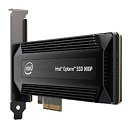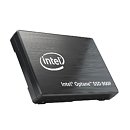Friday, October 27th 2017

Intel Launches its Blazing-Fast Optane SSD 900P SSD
Intel today announced the launch of the Intel Optane SSD 900P Series, the first SSD for desktop PC and workstation users built on Intel Optane technology. Intel, in collaboration with Roberts Space Industries, announced the new SSD at CitizenCon, a Star Citizen community gathering in Frankfurt, Germany.
The Intel Optane SSD 900P Series delivers incredibly low latency and best-in-class random read and write performance at low queue depths - up to four times faster than competitive NAND-based SSDs - opening incredible new possibilities. With the new SSDs, users will unlock more potential from their platform. The Intel Optane SSD 900P Series is ideal for the most demanding storage workloads, including 3D rendering, complex simulations, fast game load times and more. Up to 22 times more endurance than other drives also gives the heaviest users peace of mind."The Intel Optane SSD 900P Series brings the workstation-class performance and industry-leading endurance of Intel Optane technology to a client SSD for the first time, and we know end users will find exciting ways to take advantage of the drive to do great things," said Bill Leszinske, Intel vice president, Non-Volatile Memory Solutions Group, and director of strategic planning, marketing and business development. "We are eager to see the possibilities unlocked by software developers, like Roberts Space Industries with Star Citizen, and the SSD to offer users new ways to use larger data sets and more complex workloads to do more."
During the event, Intel demonstrated the unique universe of Star Citizen on Intel Core i9 processor gaming systems equipped with the Intel Optane SSD 900P Series. The two companies also announced that an exclusive in-game ship, the Sabre Raven, will come with all Intel Optane SSD 900P Series purchases for a limited time.
"The Intel Optane SSD 900P Series is amazingly fast, easily the fastest drive I have ever used," said Chris Roberts, chairman and CEO at Cloud Imperium Games and Roberts Space Industries. "Our Star Engine developers have been working on technology to improve loading times using new techniques developed for Star Citizen and optimized for the Intel Optane SSD 900P Series, which is the fastest SSD we've tested. We continue to enhance Star Citizen so the performance benefits with Intel Optane drives will continue to grow, alongside Star Citizen, into the future."
CitizenCon will be livestreamed from Frankfurt starting at 6:00 a.m. PDT Oct. 27.
The Intel Optane SSD 900P Series is available through local online retail outlets worldwide, starting Oct. 27. For more details on Star Citizen and the Sabre Raven ship, visit Roberts Space Industries. An Intel white paper on evaluating the SSD is available. For more information on the Intel Optane SSD 900P Series and Intel Optane technology, visit Intel's solid state drives page.
The Intel Optane SSD 900P Series delivers incredibly low latency and best-in-class random read and write performance at low queue depths - up to four times faster than competitive NAND-based SSDs - opening incredible new possibilities. With the new SSDs, users will unlock more potential from their platform. The Intel Optane SSD 900P Series is ideal for the most demanding storage workloads, including 3D rendering, complex simulations, fast game load times and more. Up to 22 times more endurance than other drives also gives the heaviest users peace of mind."The Intel Optane SSD 900P Series brings the workstation-class performance and industry-leading endurance of Intel Optane technology to a client SSD for the first time, and we know end users will find exciting ways to take advantage of the drive to do great things," said Bill Leszinske, Intel vice president, Non-Volatile Memory Solutions Group, and director of strategic planning, marketing and business development. "We are eager to see the possibilities unlocked by software developers, like Roberts Space Industries with Star Citizen, and the SSD to offer users new ways to use larger data sets and more complex workloads to do more."
During the event, Intel demonstrated the unique universe of Star Citizen on Intel Core i9 processor gaming systems equipped with the Intel Optane SSD 900P Series. The two companies also announced that an exclusive in-game ship, the Sabre Raven, will come with all Intel Optane SSD 900P Series purchases for a limited time.
"The Intel Optane SSD 900P Series is amazingly fast, easily the fastest drive I have ever used," said Chris Roberts, chairman and CEO at Cloud Imperium Games and Roberts Space Industries. "Our Star Engine developers have been working on technology to improve loading times using new techniques developed for Star Citizen and optimized for the Intel Optane SSD 900P Series, which is the fastest SSD we've tested. We continue to enhance Star Citizen so the performance benefits with Intel Optane drives will continue to grow, alongside Star Citizen, into the future."
CitizenCon will be livestreamed from Frankfurt starting at 6:00 a.m. PDT Oct. 27.
The Intel Optane SSD 900P Series is available through local online retail outlets worldwide, starting Oct. 27. For more details on Star Citizen and the Sabre Raven ship, visit Roberts Space Industries. An Intel white paper on evaluating the SSD is available. For more information on the Intel Optane SSD 900P Series and Intel Optane technology, visit Intel's solid state drives page.



68 Comments on Intel Launches its Blazing-Fast Optane SSD 900P SSD
There are some draw backs and limitations, but it works pretty well for accelerating HDDs. The biggest limitation is you can only use 64GB of SSD space as a cache(but hey, its bigger than 16 and 32). This set up I like to use is locating a 60GB partition on the larger main SSD to be used as a cache for the HDD in the system. So if I put a 480/500GB SSD in the system as the main system drive, and then a HDD storage drive, I make a 60GB partition on the main SSD. And then assign that as a cache for the storage HDD.
The funny thing is, the technology that Optane uses for caching has been in place by Intel for years but it used standard SSDs to accelerate HDDs. Now they are using faster drives trying to accelerate standard SSDs and HDDs. To me, Optane drives for caching is a waste of money. If you want to accelerate a HDD, just use a standard SSD, you don't need an Optane drive. And the minimal performance improvement you get from accelerating an SSD with Optane isn't worth the cost of the Optane drives.
Not sure about these new drives though.
Yes, the drives are a lot faster, but it really doesn't help the caching scenario in a noticeable way.
Speaking of, the good thing about Intel bringing this new stuff to market is maybe they'll get popular... and maybe other SSDs actually WILL get cheaper.
I'm going to stick with the 960 Pro from Sammy. Faster, cheaper and M.2 format too.
Anandtech has a review now. www.anandtech.com/show/11953/the-intel-optane-ssd-900p-review
When caching a HDD, you can use a cheaper standard SSD that is a larger size. This is a better solution than using an Optane cache drive. And normal SSDs are already fast enough that using an Optane cache drive with those makes no noticeable difference.
It's also doing something I didn't expect: Even defrag process is faster, and for some reason it tricks the OS into thinking the HDD is an SSD. So it trims instead of defrags. Do other cache drives do this? I don't get this at all, but whatever. I know it needs a reboot to set up and do some funky low level adjustments, but it's mysterious (like this).
And if you are trying to accelerate a normal SSD with an Optane SSD, you are wasting your money. Because, again, the difference isn't noticeable.
You can see and feel the difference between ~50ms, ~120ms, and ~250ms load times. Sub second response times are key to productivity.
windows 7 fade animation is 250ms 17 frames on a 60z screen. turn off fade animation and your down to 50 (3 frames), 70 (4-5 frames), and 120ms (7 frames) for various load times.
you can see and feel the difference quite easily.
here is a study that has been around since 1982 that says you are 100% wrong across the board.
jlelliotton.blogspot.com/p/the-economic-value-of-rapid-response.html
When it's you, an individual, doing the work 20ms or even 200ms is not a deal breaker. I've also used caching, 24GB RAM with primocache (R+W) accelerating a RAID 0 512GB SSD (system) drive, the same was tested without any sort of caching.
Unless the programs you're using are highly I/O latency sensitive, you'll be hard pressed to see the difference in real world. In fact I'd like you to point us to such applications & real world difference please, ATSB is not real world.
Like so: preview.ibb.co/jjEhVm/optane_defrag.jpg
As for all of this debate on Optane, it does what I expected. It does it well. I don't why people are so inclined to debate with me about using a product I already have. lol. If anyone is getting the impression I'm trying to sell them on it though, please don't. Not my intention.
You have zero anything to back your statements apart from a study wrt mainframes well over 3 & a half decades back? Is that what you call relevant in context to something like SSD or Optane?
Get back to us when you can demonstrate the effects outside of servers, there I agree it can make a huge difference, out of that human interaction will make a greater difference, on a per application basis of course.
As for Optane caching and your use, I'm not saying it doesn't work or doesn't work well. It does work well. What I'm trying to say is that there are alternatives to Optane caching, that are less restrictive(not limited to Z270, can accelerate non-system drives) and can also be more cost effective. It isn't really anything against you, what really annoys me is that most talk about Optane caching never even mention that you've been able to use a standard SSD to do the same thing for years now. Most reviews of Optane cache drives don't even bother to test with a standard SSD accelerating an HDD as well to see how minimal of a difference the Optane drive actually makes in caching vs a standard SSD used for caching.You're talking about Windows fade, but that is something specifically that is going to stay exactly the same regardless of if you are using an SSD as a cache drive or an Optane drive as a cache.
This is also a function that is very quick in the first place, going from 50ms to 250ms is a 500% increase. The entire thing takes 250ms. But when we are talking about a Windows booting, that is something that takes 15 seconds, so the difference of 1s is a 6% difference. See how that is a lot less noticeable? These are the scenarios that improve with Optane cache/SSD cache. We are talking about things that take multiple seconds to complete, not a few ms. We aren't talking about things that we click and expect a near instant response.
If you're right, you're right. But there isn't much written about any of it.. or what it 's doing at the setup process. You say this like you know, when Intel doesn't bother telling anyone anything. No offense, but..
I'm just asking what it's actually doing. I just wanted details about the process. If it's just the cache, then there isn't a point in doing at all then.
That all said, it appears 32GB trim takes as long as my 256 and 512 SSDs. They're all that fast.